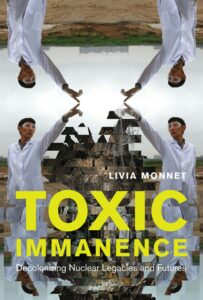 Edited by Livia Monnet, Foreword by Magdalena E. Stawkowski. McGill-Queen’s University Press, 2022
Edited by Livia Monnet, Foreword by Magdalena E. Stawkowski. McGill-Queen’s University Press, 2022
This interdisciplinary edited collection examines twentieth and twenty-first century nuclear industries and cultures from the perspective of nuclear humanities, energy humanities and environmental humanities. Positioning itself at the intersection of postcolonial, decolonial, feminist, new materialist, and indigenous environmental science approaches, Toxic Immanence advocates for resistance to, and for the unconditional abolition of nuclear complexes and of the global nuclear regime. Some of its contributions highlight little known aspects of the history and aftereffects of the Chernobyl and Fukushima nuclear disasters, while other chapters reexamine Cold War and post-Cold War anti-nuclear movements, arts, and visual cultures. The volume’s contributors also call for intersectional, decolonizing analyses of nuclear discourses and technologies and their instrumentalization by “green” capitalism. The poetry and photography featured in the collection evoke the ongoing legacies of the atomic bombing of Hiroshima, of Cold War nuclear testing and the Fukushima nuclear disaster while insisting that the struggle against colonial nuclear regimes must continue. With a Foreword by Magdalena E. Stawkowski and a Postface by Jessica Hurley.
Table of Contents:
Foreword | The Atomic Now, MAGDALENA E. STAWKOWSKI;
Introduction | Toxic Immanence: Toward Decolonizing Pedagogies of the Nuclear, LIVIA MONNET ;
ONE Aftereffects of Chernobyl and Fukushima
1 “The Future Is Behind Them!”: Post-Apocalypse and the Enduring Nuclear in Post-Soviet Russian Fiction, SHARAE DECKARD;
2 From Toxic Lands to Toxic Rumours: Nuclear Accidents, Contaminated Territories, and the Production of (Radio)active Ignorance, SEZIN TOPÇU;
3 The Fukushima Process, SABU KOHSO;
4 Fukushima and the Rebuild of Godzilla: Multiplying Media in an Era of Multiplying Disaster, THOMAS LAMARRE;
Afterword | Repeating, Multiplying: The Ongoing Now of Nuclear Aftereffects, DANIEL C. O’NEILL;
TWO The Cold War and Post–Cold War Nuclear State and Its Geopolitics: Imaginaries and Contestations
5 Shaking, Trembling, Rattling, Shouting: Seismic Politics in the Nuclear Age, JOSEPH MASCO;
6 What Is the Matter with Nuclear Weapons Communication?, BRYAN C. TAYLOR;
7 The National Toxic Land/Labor Conservation Service: 10-Year Final Report on Public Agency Organizing and Operational Responses to Cold War Legacies and the Nuclear Stockpile, SARAH KANOUSE AND SHILOH KRUPAR;
8 Sounding Out the Nuclear: An Atomic Opera, JULIET PALMER, JULIE SALVERSON, AND PETER C. VAN WYCK;
9 Poetry and Anti-Nuclearism: Τεχνη and the “Fundamental Project,” JIM KRAUS;
Afterword | Fears and the (Nuclear) Apocalypse: Who Is Afraid of What? KARENA KALMBACH;
THREE Archaeologies and Heritages
10 Emergency/Salvage Archaeology: Excavating Media and Uranium in the Glen Canyon, THOMAs PATRICK PRINGLE;
11 Nuclear Waste as Critical Heritage, CORNELIUS HOLTORF AND ANDERS HÖGBERG;
Afterword | Lingering Radiation: On Violent Pasts and Open-Ended Futures, RUBY DE VOS;
FOUR Nuclear Aesthetics: Contemporary Art, Nuclear Colonialism, and the Transformation of Life and the Environment
12 Atomic Aborigines: Appropriation and Colonization of Indigenous Australia during British Nuclear Testing, MICK BRODERICK ;
13 The Antipodean Stance of Pam Debenham’s 1980s Screenprints N.A.J. TAYLOR;
14 The Immanation-Image: Immanent Experience and Kazakhstan’s Socialist and Postsocialist Modernity in Almagul Menlibayeva’s Video Installation Transformation (2016), LIVIA MONNET;
Afterword | The Possibility of a Situated Nuclear Knowledge: Art in Contaminated Sites, KYVELI MAVROKORDOPOULOS
FIVE Artists’ Contributions
15 Inheritance: Radiant Reflections from Hiroshima, Nagasaki, and Fukushima: 20 Poems by Bo Jacobs for 20 Photographs by elin O’Hara slavick 0, ROBERT (BO) JACOBS AND ELIN O’HARA SLAVICK ;
16 Nuclear Family: A Poem, CRAIG SANTOS PEREZ;
Postface | Unmaking the Nuclear Future, JESSICA HURLEY
